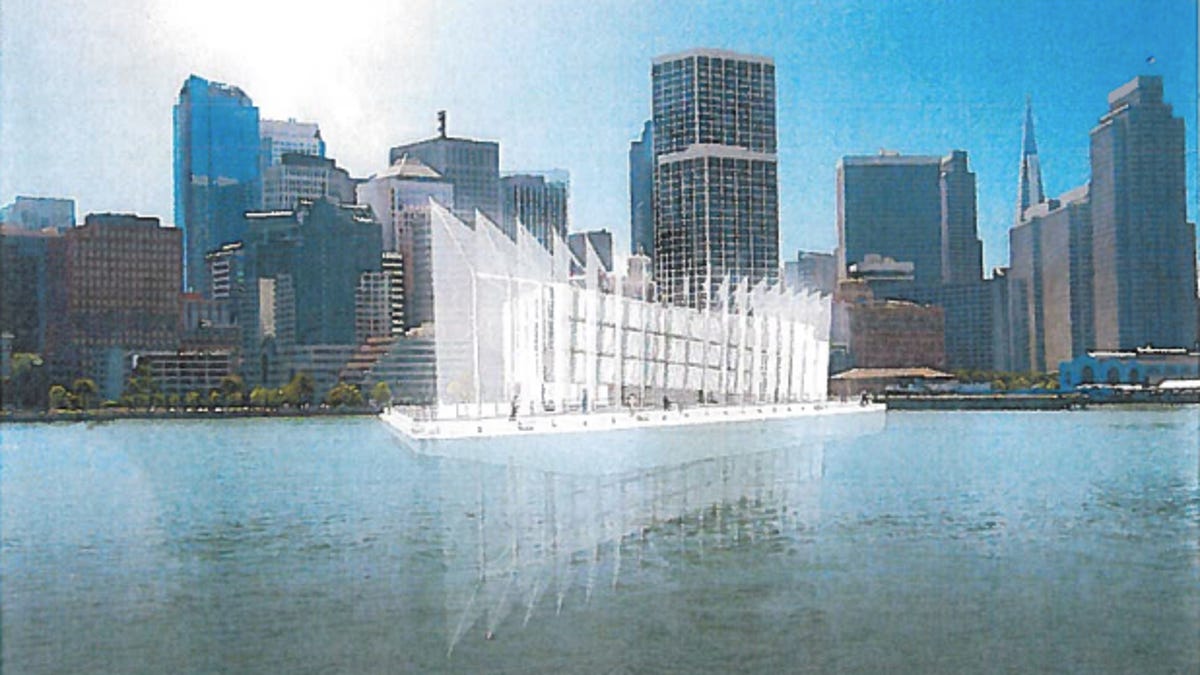Google Barge to feature sails, be temporary exhibit space
According to documents from the Port of San Francisco, the now-famous mystery structure is intended to be an exhibition space and draw people to the San Francisco bay waterfront.

The once-mysterious Google Barge is becoming less and less so every day.
A new report from The San Francisco Chronicle suggests that the large structure currently under construction in San Francisco Bay is intended to be a large exhibition space, covered in sails, and meant to be docked in various places around the bay for a month or so at a time, and then set sail for other cities on the West Coast.
The Chronicle's report is based on documents it received from the Port of San Francisco, which were also provided to CNET by CBS' San Francisco affiliate KPIX. CBS is the parent company of CNET. The documents show detailed plans for the barge-based structure, which CNET was first to connect to Google.
CNET had previously requested information about the project from the Port of San Francisco, but was told the agency had none.
According to the Chronicle, which received the documents via a Freedom of Information Act request, the structure's builder went into some details about what it was supposed to be:
When it's done, the barge's backers say, the 50-foot-tall, 250-foot-long structure made of recycled shipping containers will be flanked by sails "reminiscent of fish fins, which will remind visitors that they are on a seaworthy vessel."
"The structure will stand out," the team says, in what is probably an understatement.
By and Large LLC, which submitted the barge documents, refers to the vessel as a "studio" and "temporary technology exhibit space." It says its goal is to "drive visitation to the waterfront."
The barge's exhibit space, it says, will be for "local organizations to engage with guests and gain visibility in a unique way."
"We envisioned this space with community in mind," By and Large says, "a surprising environment that is accessible to all and inspires conversation about how everything is connected -- shorebirds, me, you, the sea, the fog and much more."
On Wednesday, Google spoke publicly for the first time about what has become known widely as "Google barge:" "Google Barge ... A floating data center? A wild party boat? A barge housing the last remaining dinosaur? Sadly, none of the above," Google said in a statement. "Although it's still early days and things may change, we're exploring using the barge as an interactive space where people can learn about new technology."
The Chronicle's story doesn't address the ultimate purpose of a second Google barge that is currently located in Portland, Maine. But it is safe to assume that Google had very much the same goal in mind for that structure.
Oddly, though Google has confirmed its connection to the project -- as have at least two public agencies, the San Francisco Bay Conservation and Development Commission (BCDC) and the National Park Service -- there is no mention of Google in the documents.
Called the "San Francisco Studio" in the documents, the floating building was expected to be serving its finished purpose from November 2013 through November 2014. That time frame has been delayed at least somewhat, however, as the Google Barge sits, still covered in scaffolding and dark netting, alongside Pier 1 on Treasure Island. The schedule laid forth in the documents called for the structure to have moved to Fort Mason in San Francisco by now.
Interestingly, the documents suggest that the barge would be moved between several San Francisco locations, and that it was believed that those spots had "already been permitted for the mooring of vessels and that no additional BCDC permitting would be required."
But Larry Goldzband, BCDC's executive director, told CNET last week that the agency had not issued any permits to Google for the project, and that it wouldn't until it was convinced that the barge would not be considered "fill in the bay," a term meaning a vessel moored there for too long.
The documents do suggest BCDC permitting might be required for some locations, but the agency was clear that it had given no permission at all.
In any case, Google must be hoping that it can one day unveil the finished product -- which KPIX reported would be an invite-only showroom for Google X products and projects. The documents do refer to a crowd-management plan that will call for "creating an invitation system to limit the number of people that wait in line to board the vessel." The plan also reveals that the structure is made from recycled shipping containers providing 13,726 square feet of space, and that it will feature three stories of public space, including two levels for technology demonstrations, and a fourth floor roof and deck space.
Google did not immediately respond to a request for comment about the newly-surfaced documents.

